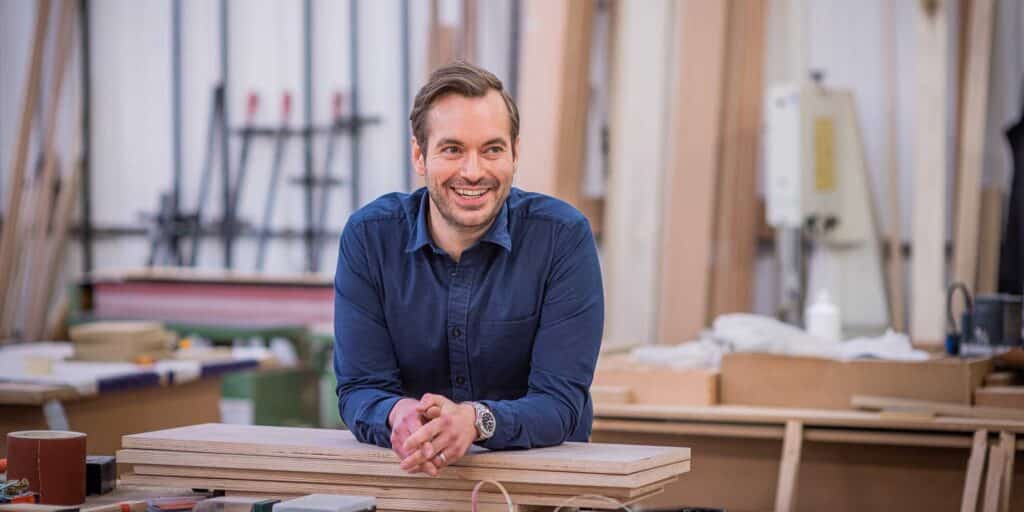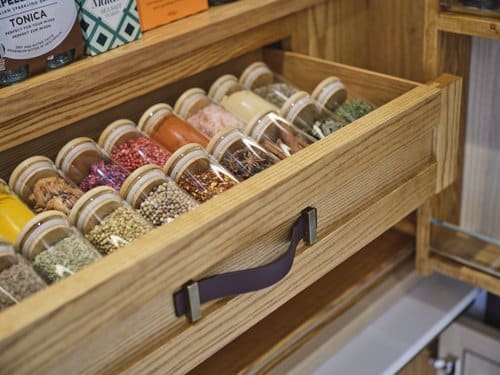The Evolution of Internal Cabinetry
Clive Christian has long been known for its exceptional craftsmanship and bespoke service, and this care and attention to detail applies just as much to the interiors of our cabinets as it does to the exteriors.
Though it may be largely hidden from view, internal cabinetry serves an important functional purpose, and can also be an opportunity to have some fun aesthetically. We work closely with our clients to craft custom storage solutions from thoughtful and sustainable materials, while reflecting their taste and personality with colour, pattern and materials.
From pull-out pilasters to shoe racks and sock divides, our Head of Design, Oliver Deadman, talks us through the evolution of internal cabinetry.
What is internal cabinetry?
Internal cabinetry refers to the features that sit inside a cabinet, which are usually determined by the purpose of the room, whether it’s a kitchen, reception area or dressing room.
Internal cabinetry was traditionally led by function rather than form, but at Clive Christian we’ve seen it as an opportunity to further embellish our cabinetry by using beautiful materials and the same level of craftsmanship and detail that you would apply to the exterior.
How have you seen the kitchen space evolve?
In the past, the main kitchen in a home was used predominantly as an entertaining area rather than for preparing food. It would serve as a glamorous, statement space, with a pared-back area off at one side where the actual cooking was done.
Over the last couple of decades, there has been an increasing interest in cooking and food preparation in line with the rise of the celebrity chef. Brands like Miele and Sub-zero Wolf are producing restaurant-quality appliances for use at home, so kitchens that were previously “look but don’t touch” are now fitted with professional equipment like vacuum drawers and steam ovens.
What about dressing rooms?
As with kitchens, our goal is to make the dressing room experience feel fully designed throughout. Storage features include presentation racks for shoes: angular shelves lined with leather with a glass upstand that the shoe collection can hook over. We’re increasingly using LED lighting for display purposes too.
For internal drawer setups, we’re seeing lots of glass and leather, as well as partition divides for jewellery, tie inserts and sock divides made with beautiful fabrics and designs. We’re also using timber cabinetry elements to house these in a decorative manner that elevates the experience of getting dressed in the morning.
What entertainment features are you integrating?
In the dressing room we’re integrating inset coffee machines and discreet cooling areas for drinks as the space evolves into more of an entertaining area.
We’re also fitting audio systems so you can enjoy a drink and listen to music while you get ready to go out. The dressing room is no longer purely functional, it’s somewhere you can have a bit of fun.
Similarly, in the kitchen, we’re integrating products like Kaelo, which uses military-grade cooling hardware to rapid-chill bottles of wine.
What new technology can clients expect?
Home integration is becoming increasingly popular. We’re installing Lutron systems that control lights and music, so clients can regulate the emotions of the house, and we need to ensure our cabinetry works with those systems.
Charging stations are also very popular – you can throw your phone into a drawer and let it charge while it’s out of sight.
Safety is a really important factor too. We work with Chubb, who have a fantastic product that uses fingertip recognition to open a cabinet door. The top line of the cabinet pops open to reveal a safe drawer for storing your keys, wallet and phone. It was originally developed for hotels and it’s insulated against signal bouncing devices to prevent car theft.
How can interior cabinetry be personalised?
We often use the analogy of the Paul Smith business suit – you’ve got the elegant, professional exterior, and then inside there’s a fantastic, vibrant lining, which reflects the wearer’s personality.
The same is true of our cabinets: the exterior grandeur opens up to reveal a beautiful inner space, which is appointed to the level you’d expect from Clive Christian. We might introduce a pop of colour from a fabric lining, or we might use vegan alternatives to leather, like jute. One client asked us to work with coconut husk, which is similar to felt. We have a lot of fun thinking about what materials to use and how we can cater for the client and make them feel special.
All Clive Christian Furniture rooms are designed around the client’s specific requirements, and the scale and proportion of the appliances. For further information or to make an enquiry, please contact us.








